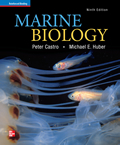
Marine Biology (Castro), 9th EditionChapter 12: Estuaries: Where Rivers Meet the SeaFor Further ReadingStep, D., 2002. Living on the edge. Audubon, vol. 104, no. 2, September, pp. 62–77. The preservation of estuaries and other wetlands is crucial for the survival of many shorebirds. Barbier, E. B. and M. Cox, 2003. Does economic development lead to mangrove loss? A cross-country analysis. Contemporary Economic Policy, vol. 21, no. 4, pp. 418–432. Haertel-Borer, S. S., D. M. Allen and R. F. Dame, 2004. Fishes and shrimps are significant sources of dissolved organic nutrients in intertidal salt marsh creeks. Journal of Experimental Marine Biology and Ecology, vol., 311, no. 1, pp. 79–99. Hughes, R. G., 2004. Climate change and loss of saltmarshes: consequence for birds. Ibis, vol. 146 (suppl.), no. s2, pp. 21–28. Nordlie, F. G., 2003. Fish communities of estuarine salt marshes of eastern North America, and comparisons with temperate estuaries of other continents. Reviews in Fish Biology and Fisheries, vol. 13, no. 3, pp. 281–325. Pennings, S. C., M. Grant and M. D. Bertness, 2005. Plant zonation in low-latitude salt marshes: disentangling the roles of flooding, salinity, and competition. Journal of Ecology, vol. 93, no. 1, pp. 159–167. Thurman, C., 2004. Unravelling the ecological significance of endogenous rhythms in intertidal crabs. Biological Rhythm Research, vol. 35, no. 1–2, pp. 43–67. Watts, R. J. and M. S. Johnson, 2004. Estuaries, lagoons, and enclosed embayments: habitats that enhance population subdivision of inshore fi shes. Marine and-Freshwater Research, vol. 55, no. 7, pp. 641–651. http://www.cdc.gov/ncidod/dbmd/diseaseinfo/vibriovulnificus_g.htm |  |















